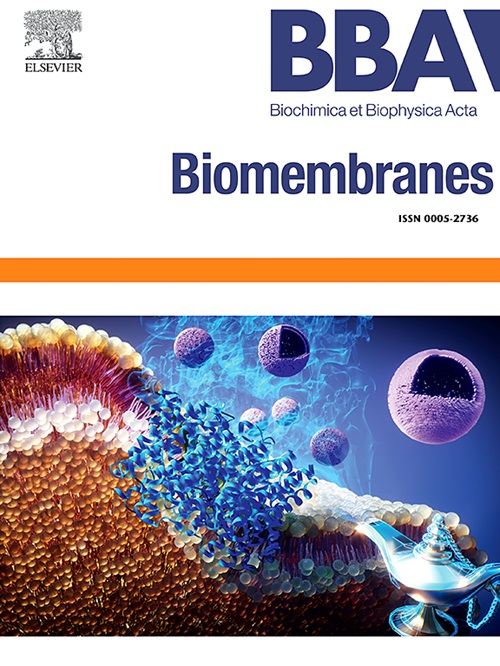Complexes of star-shaped block copolymers of poly(2-alkyl-2-oxazine)s and curcumin can affect lipid bilayers mimicking biomembranes
IF 2.5
3区 生物学
Q3 BIOCHEMISTRY & MOLECULAR BIOLOGY
引用次数: 0
Abstract
Poly(2-alkyl-2-oxazine)s (PAlOz) are promising tools for developing delivery systems due to their high biocompatibility, resistance to enzyme hydrolysis, and ability to degrade in biological environments. Here, we investigated the effects of hexaaza[26]cyclophane (CPh6), poly(2-methyl-2-oxazine) (PMedOz), a block copolymer of poly(2-ethyl-2-oxazine) (PEtOz) and poly(2-isopropyl-2-oxazine) (PiPrOz), star-shaped block copolymers with six PAlOz arms and a CPh6 branching center (CPh6-PAlOz), and the complexes of all these macromolecules with curcumin on lipid bilayers mimicking the membranes of normal and cancer cells. Curcumin alone demonstrated a pronounced ability to reduce the boundary potential of lipid bilayers composed of phosphatidylcholine or phosphatidylserine, while PMedOz and PEtOz-b-PiPrOz copolymers exhibited either no or weak effects on the electrical properties of biomimetic model membranes. CPh6-PAlOz star-shaped block copolymers were able to interact with K+-nonactin. Differential scanning microcalorimetry of the gel-to-liquid crystalline phase transition of membrane lipids indicated that curcumin and all tested macromolecules had more pronounced effects on phosphatidylserine melting than on the phase behavior of phosphatidylcholine. A star-shaped block copolymer with a [PEtOz]/[PiPrOz] ration of 0.8 significantly decreased the melting point of phosphatidylserine. The disordering effects of complexes of curcumin with CPh6, PEtOz-b-PiPrOz copolymers, or the CPh6-PAlOz star-shaped block copolymer with a [PEtOz]/[PiPrOz] ratio of 5 on phosphatidylserine bilayers were less than the algebraic sum of the effects of the polymers and curcumin separately. These data indicate that the carrier cannot be considered an inert matrix that does not affect the biological activity of the transferred active compound, and this should be taken into account when assessing the biological consequences.

聚(2-烷基-2-氧嗪)s和姜黄素的星形嵌段共聚物配合物可以影响模拟生物膜的脂质双层
聚(2-烷基-2-恶嗪)s (PAlOz)由于其高生物相容性、抗酶水解和在生物环境中降解的能力而成为开发递送系统的有前途的工具。在这里,我们研究了六氮杂环烷(CPh6),聚(2-甲基-2-恶嗪)(PMedOz),聚(2-乙基-2-恶嗪)(PEtOz)和聚(2-异丙基-2-恶嗪)(PiPrOz)的嵌段共聚物,具有六个PAlOz臂和一个CPh6分支中心的星形嵌段共聚物(CPh6-PAlOz),以及所有这些大分子与curcumin的配合物对模拟正常和癌细胞膜的脂质双层的影响。姜黄素可以明显降低磷脂酰胆碱或磷脂酰丝氨酸组成的脂质双分子层的边界电位,而PMedOz和PEtOz-b-PiPrOz共聚物对仿生模型膜的电学性能没有或只有微弱的影响。CPh6-PAlOz星形嵌段共聚物能够与K+-非肌动蛋白相互作用。膜脂凝胶-液晶相变的差示扫描微热法表明,姜黄素和所有被测大分子对磷脂酰丝氨酸熔融的影响比对磷脂酰胆碱相行为的影响更为显著。[PEtOz]/[PiPrOz]比为0.8的星形嵌段共聚物显著降低了磷脂酰丝氨酸的熔点。姜黄素与CPh6、PEtOz-b-PiPrOz共聚物或[PEtOz]/[PiPrOz]比为5的CPh6- paloz星形嵌段共聚物的配合物对磷脂酰丝氨酸双分子层的无序作用小于聚合物与姜黄素各自作用的代数和。这些数据表明,载体不能被认为是不影响转移活性化合物生物活性的惰性基质,在评估生物后果时应考虑到这一点。
本文章由计算机程序翻译,如有差异,请以英文原文为准。
求助全文
约1分钟内获得全文
求助全文
来源期刊

Biochimica et biophysica acta. Biomembranes
生物-生化与分子生物学
CiteScore
8.20
自引率
5.90%
发文量
175
审稿时长
2.3 months
期刊介绍:
BBA Biomembranes has its main focus on membrane structure, function and biomolecular organization, membrane proteins, receptors, channels and anchors, fluidity and composition, model membranes and liposomes, membrane surface studies and ligand interactions, transport studies, and membrane dynamics.
 求助内容:
求助内容: 应助结果提醒方式:
应助结果提醒方式:


